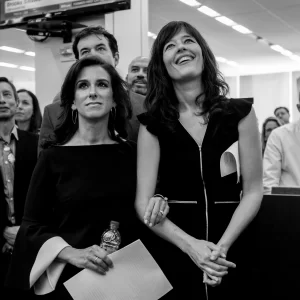‘Black Panther: Wakanda Forever’ Revives Phase 4 of Marvel
The Marvel film acts as a shimmering legacy and mosaic of grief
November 21, 2022
Warning: Spoilers for “Black Panther: Wakanda Forever”
“Black Panther: Wakanda Forever” was released last week on Nov. 11, just over four years after the premiere of Marvel’s highly acclaimed “Black Panther.” The reception of the 2018 film created much anticipation among fans for the sequel, with many curious about how the storyline would alter after the unfortunate passing of Chadwick Boseman in 2020, who played the titular role.
If you did not scramble to the theater opening weekend and were lucky enough not to be spoiled by Twitter rants, be warned that “Wakanda Forever” does not stray away from discussions of grief and life after losing a loved one.
The movie opens with the traditional Marvel logo, but instead of the triumphant opening theme and flashes of Iron Man, Black Widow, Thor and the Marvel Cinematic Universe (MCU) suite, clips of Boseman are featured with no accompanying sound. The audience shares a moment of silence for the beloved Boseman. This introduction sets the tone for what is to come in the film.
“Wakanda Forever” opens with Shuri (Letitia Wright), princess of Wakanda and sister to King T’Challa. She is in her lab attempting to create an artificial heart-shaped herb that has incredible healing capability and grants the Black Panther its powers. In her determination, she misses the passing of her brother, the Black Panther, who she was ultimately trying to use the herb to save from an unnamed disease.
There then is a funeral ceremony for King T’Challa with all of our favorites from the first movie: Okoye (played by Danai Gurira), M’Baku (played by Winston Duke) and the former Queen Ramonda (played by Angela Bassett). It is a moving scene with an aerial shot of all Wakandans wearing white mourning garbs and performing one last Wakanda salute to the Black Panther.
Queen Ramonda attends a meeting of the United Nations where representatives demand that Wakanda open its borders and trade to give other countries access to their vibranium source. Ramonda declines and reveals that foreign troops have already attempted to steal the metal. This is partnered with a scene of the mighty Dora Milaje fighting off French soldiers in a vibranium lab. While the fight scene is entertaining, it is light work for the Dora Milaje. Actress Michaela Coel, known for the series “Chewing Gum” and “I May Destroy You,” joins the group of Wakanda’s fiercest protectors as Aneka.
The success of “Black Panther” was rooted in its diverse narrative — centering a Black superhero in a time of great racial tension — and its complex storytelling of past and present colonization.
Meanwhile, one of the CIA’s military-grade ships is sunk after a mission to extract a new source of vibranium detected in the Atlantic. A siren song entrances the crew members before the ship goes under, each of them jumping off the boat into the freezing ocean. In the aftermath, the U.S. government blames Wakandans for the attack.
In the midst of it all, Shuri struggles with her brother’s death. At the one-year anniversary of his passing, Ramonda takes Shuri to burn the funeral clothes they adorned, a tradition used to symbolize the end of the mourning period. Shuri has not taken a moment to breathe since T’Challa’s death, burying herself instead in the comfort of her lab.
Director Ryan Coogler, who also directed the first film, spends time weaving the consequence of unacknowledged grief through the narrative. Shuri struggles to believe in an ancestral plane where her brother resides — this will burden her up until the climax of the film.
While Ramonda and Shuri argue over the importance of tradition, they are interrupted by a man who emerges from the water. Mexican actor Tenoch Huerta makes his debut on the silver screen as Ku’ku’lkán, the feathered serpent god — known by many as Namor. Namor is the ruler of an underwater kingdom, Talokan. He blames the Black Panther for bringing attention to the existence of vibranium, which puts his kingdom at risk as they are in possession of vibranium as well. He warns them that the empire of Talokan will start a war with Wakanda if they do not find the scientist who created a vibranium detector.
Given a tip by Black Panther’s resident white boy detective Everett Ross (played by Martin Freeman), Okoye and Shuri travel to Boston to confront the creator of the detective, who is not an old, mad scientist but instead Massachusetts Institute of Technology student Riri Williams, played by Dominique Thorne.
The success of “Black Panther” was rooted in its diverse narrative — centering a Black superhero in a time of great racial tension — and its complex storytelling of past and present colonization. Boseman’s performance and dedication to the role impacted many Black viewers.
“Wakanda Forever” continues this legacy by exploring the history of the Mayan people. Namor’s cousin and right hand Namora, played by Mexican actress Mabel Cadena, is a force to be reckoned with, leading the powerful Talokanils into battle. The Talokanils represent the often unsung history of the beauty of Mesoamerica.
“Black Panther: Wakanda Forever” is a must-watch. A Mayan god’s demanding claim, the Western world closing in on Wakanda and Shuri’s bottled-up grief and guilt create a compelling narrative that competes well with the first movie.
The film is a strong addition to the lackluster MCU Phase Four. Coogler crafts a beautiful story of anguish after loss while also highlighting the monstrosity of colonization and finding the power within.













